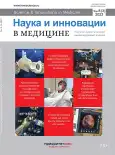Pathogenetic significance of CD3+CD56+ T-lymphocytes in hemorrhagic fever with renal syndrome
- Authors: Ivanov M.F.1, Konstantinov D.Y.1, Balmasova I.P.2, Ulitina A.Y.1
-
Affiliations:
- Samara State Medical University
- A.I. Evdokimov Moscow State University of Medicine and Dentistry
- Issue: Vol 8, No 3 (2023)
- Pages: 176-180
- Section: Infectious diseases
- URL: https://journal-vniispk.ru/2500-1388/article/view/249946
- DOI: https://doi.org/10.35693/2500-1388-2023-8-3-176-180
- ID: 249946
Cite item
Full Text
Abstract
Aim – to evaluate the pathogenetic role of T-lymphocytes carrying the natural killer marker CD56 in hemorrhagic fever with renal syndrome (HFRS).
Material and methods. The study group included 65 patients with HFRS receiving the inpatient treatment in the Clinics of SamSMU, and 15 healthy people were chosen for the control group. The following examinations were scheduled for all patients in the different stages of the disease: a clinical blood test, flow cytometry with a given set of monoclonal antibodies, enzyme-linked immunosorbent assay of blood serum to determine the cytokine profile. For statistical analysis we used the SPSS v.23 software.
Results. The percentage of CD3+ CD56+ NKT blood content in comparison with those for cells of innate immunity (neutrophil granulocytes, monocytes, natural killers) and lymphocytes of adaptive immune response, as well as the level of cytokines in the blood serum showed that in polyuric and convalescent periods, the number of these cells significantly increases and remains closely embedded in correlations with other components of the immune system.
Conclusion. A new hypothesis has been proposed to interpret the role of NKT in the development of the immune response in HFRS.
Full Text
##article.viewOnOriginalSite##About the authors
Mikhail F. Ivanov
Samara State Medical University
Author for correspondence.
Email: m.f.ivanov@samsmu.ru
ORCID iD: 0000-0002-2528-0091
PhD, Associate professor, Department of General and Clinical Microbiology, Immunology and Allergology
Russian Federation, SamaraDmitrii Yu. Konstantinov
Samara State Medical University
Email: d.u.konstantinov@samsmu.ru
ORCID iD: 0000-0002-6177-8487
PhD, Associate professor, Head of the Department of Infectious Diseases with Epidemiology
Russian Federation, SamaraIrina P. Balmasova
A.I. Evdokimov Moscow State University of Medicine and Dentistry
Email: iri.balm@mail.ru
ORCID iD: 0000-0001-8194-2419
PhD, Professor, Head of the Laboratory of Infectious Diseases Pathogenesis and Treatment Methods
Russian Federation, MoscowAlina Yu. Ulitina
Samara State Medical University
Email: a.ju.ulitina@samsmu.ru
ORCID iD: 0000-0003-0452-2781
assistant of the Department of Infectious Diseases with Epidemiology
Russian Federation, SamaraReferences
- Brocato RL, Hooper JW. Progress on the prevention and treatment of hantavirus disease. Viruses. 2019;11(7):610. doi: 10.3390/v11070610
- Valishin DA, Shestakova IV, Murzabaeva RT, et al. Hemorrhagic fever with renal syndrome in adults. Clinical recommendations. Non-profit partnership "National Scientific Society of Infectious Diseases", 2016:49. (In Russ.). [Валишин Д.А., Шестакова И.В., Мурзабаева Р.Т., и др. Геморрагическая лихорадка с почечным синдромом у взрослых. Клинические рекомендации. Некоммерческое партнерство «Национальное научное общество инфекционистов», 2016:49].
- Morozov VG, Ishmukhametov AA, Dzagurova TK, Tkachenko EA. Clinical features of hemorrhagic fever with renal syndrome in Russia. Infectious diseases. 2017;5:156-161. (In Russ.). [Морозов В.Г., Ишмухаметов А.А., Дзагурова Т.К., Ткаченко Е.А. Клинические особенности геморрагической лихорадки с почечным синдромом в России. Инфекционные болезни. 2017;5:156-161].
- Alekhin EK, Kamilov FKh, Khunafina DKh, et al. Hemorrhagic fever with renal syndrome. Medical Bulletin of Bashkortostan. 2013;5:24-31. (In Russ.). [Алехин Е.К. Камилов Ф.Х., Хунафина Д.Х., и др. Геморрагическая лихорадка с почечным синдромом. Медицинский вестник Башкортостана. 2013;5:24-31].
- Melnikov VL, Aftaeva LN, Mitrofanova NN, Tsyplikhin NO. Clinical and epidemiological characteristics of hemorrhagic fever with renal syndrome in the Penza region and the city of Penza. Modern problems of science and education. 2022;6(part 1). (In Russ.). [Мельников В.Л., Афтаева Л.Н., Митрофанова Н.Н., Цыплихин Н.О. Клинико-эпидемиологическая характеристика геморрагической лихорадки с почечным синдромом в Пензенской области и городе Пензе. Современные проблемы науки и образования. 2022;6(часть 1)]. URL: https://science-education.ru/ru/article/view?id=32267 doi: 10.17513/spno.32267
- Jiang H, Wang LM, Wang PZ, Bai XF. Hemorrhagic fever with renal syndrome: pathogenesis and clinical picture. Front Cell Infect Microbiol. 2016;6:1-14.
- Manigold T, Vial P. Human hantavirus infections: epidemiology, clinical features, pathogenesis and immunology. Swiss Med Wkly. 2014;144:13937-13955. doi: 10.4414/smw.2014.13937.
- Serris A, Stass R, Bignon EA, et al. The hantavirus surface glycoprotein lattice and its fusion control mechanism. Cell. 2020;183(2):442-456.e16.
- Reuter M, Krüger DH. The nucleocapsid protein of hantaviruses: much more than a genome-wrapping protein. Virus Genes. 2018;54(1):5-16. doi: 10.1007/s11262-017-1522-3
- Antoine M, Langlois ME, Bres E, et al. Imported haemorrhagic fever with renal syndrome caused by Dobrava-Belgrade hantavirus in France. Clin Kidney J. 2021;14(3):1014-1016. doi: 10.1093/ckj/sfaa006
- Balmasova IP, Nesterova IV, Malova ES, Sepiashvili RI. Structural and functional organization of the immune system. M., 2019. (In Russ.). [Балмасова И.П., Нестерова И.В., Малова Е.С., Сепиашвили Р.И. Структурно-функциональная организация иммунной системы. М., 2019].
- Braun M, Bjokstrom NK, Gupta S, et al. NK cell activation in human hantavirus infection explained by virus-induced IL-15/IL15Rα expression. PLoS Pathol. 2014;10(11):e1004521. doi: 10.1371/journal.ppat.1004521
- Gupta S, Braun M, Tischler ND, et al. Hantavirus-infection confers resistance to cytotoxic lymphocyte-mediated apoptosis. PLoS Pathol. 2013:9(3):e1003272. doi: 10.1371/journal.ppat.1003272
- Juno JA, Keynan Y, Fowke KR. Invariant NKT cells: Regulation and function during viral infection. PLoS Pathog. 2012;8(8):e1002838.
- Vogt S, Mattner J. NKT cells contribute to the control of microbial infections. Front Cell Infect Microbiol. 2021;11:718350. doi: 10.3389/fcimb.2021.718350
- Trottein F, Paget C. Natural killer T cells and mucosal-associated invariant T cells in lung infections. Front Immunol. 2018;9:1750. doi: 10.3389/fimmu.2018.01750
- Ivanov MF, Balmasova IP, Zhestkov AV, et al. Expression of NKG2D by cytotoxic T-lymphocytes as a possible mechanism of immunopathogenesis of hemorrhagic fever with renal syndrome. Immunology. 2023;44(1):93-102. (In Russ.). [Иванов М.Ф., Балмасова И.П., Жестков А.В., и др. Экспрессия NKG2D цитотоксическими Т-лимфоцитами как возможный механизм иммунопатогенеза геморрагической лихорадки с почечным синдромом. Иммунология. 2023;44(1):93-102]. doi: 10.33029/0206-4952-2023-44-1-93-102
- Perez C, Prajapati K, Burke B, et al. NKG2D signaling certifies effector CD8 T cells for memory formation. J Immunother Cancer. 2019;7:48. doi: 10.1186/s40425-019-0531-2
- Tomura M, Yu WG, Ahn HJ, et al. A novel function of Valpha14+CD4+ NKT cells: stimulation of IL-12 production by antigen-presenting cells in the innate immune system. J Immunol. 1999;163:93-101.
Supplementary files








